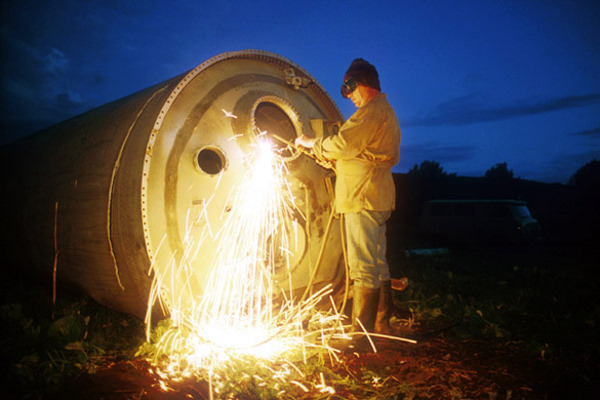Background
After finishing his one year internship at Magnum Photos, Bendiskon travelled to Russia in an attempt to pursue a career as a photographer. At this point the USSR had only been abolished as little of 10 years before and the people of Russia were starting to adjust to life away from Communism after over 70 years. Bendiksen decided to photograph different parts of Russia, documenting this tranisition, aswell as remaining traces of the previously exisiting USSR.
Narrative
Bendiksen begins the narrative with eerie images of the Russian landscape, and silhouette styled portraits of unaware subjects. Straight away within the story the viewer is immediately connected to the theme of loneliness and isolation. Arguably this connects to the context of the narrative, being the documentation of how Russia is adjusting to lfe outside of communism. These types of image are a metaphor for the Russian people’s sense of insecurity and search for a new identity in a time of great social change. The opening images also show Russia in a very glim perspective: showing dark, depressing and cold scenes.

Throughout the narrative, subtle hints to traces of Russia’s Communist past are present. Relative to Bendisken’s poetic style, these hints are very covert. The references to communism, for example the image which include framed photographs of Lenin and Marx, help to build up the context of the story, allowing the viewer to develop a degree of understanding and empathy for the communities he photographs.

As the story progresses, Bendisken photos begin to reveal more about the communities. He starts to include images moving away from a candid style, progressing onto more formal portrait style, in which he engages and interacts which the subjects more. Also Bendkisen begins to include images of the communities engaging in events and activities, such as dancing, hunting and military training. The images gradually become more revealing about the people and the communities in contrast to the initial sense of mystery.
The images are all connected through the theme of community. Oppose to photographing individuals, large masses of people or families, Bendiksen has based the series on photographing small communities throughout Russia. One community in particular that Bendiksen has photographed is a community of Satellite collectors; people who make a living out of selling scrap metal from fallen satellite ships and rockets from the Cold War. The inclusion of this story I find works very well because it links the theme of past and present: the fallen satellites are metaphorically a trace of Russia’s communist past, and the community of collectors symbolise how Russia is moving on from this past, whilst remembering it at the same time.

The viewer is drawn to be empathetic towards the communities. The communities are shown in a very respectable light, seen as honourable for carry on with great optimism and positivity despite the uncertain political and economic times. The series champions the Russian people as brave and resilient, holding on to their patriotic, cultural identity in a forever changing world. Community in Russia is also shown to be fragile and Bendisken documents this vulnerability through the dark and reflective moods he establishes in some of his images, especially early on.
Style of Photographs
Bendiksen’s unusual style of photographing is apparent throughout the book. His style is very photojournalist and he makes little attempt to interfere with the frame, allowing for a spontaneous and natural flow to emerge through the images. The role of a photojournalist is to document the world from an objective, distant perspective. This sense of distant and separation from his subjects is clearly shown. Bendkisen’s photos are very mysterious, often images of lone, unobserved subjects. As a result, the mood established in ‘Satellites’ is very chilling and dark, reflectingg the grim, barren landscape of Russia. I find Bendiksen’s style to be very subtle and poetic in meaning. In contrast to photographers such as Richard Billigham and Bruce Gilden, who shoot images which are deliberately upfront, snap-shot styles with bold composition: Bendisken has a much more observed and laid back approach. Carefully considered, well balanced composition is key to Bendiksen’s work.

What I find effective about Bendisken’s work in ‘Satellites’ is the way that he is able to balance technical composition with subjective aspects of mood. Bendiksen’s photos still have a structure composition whilst incorporating an natural mood, sometimes photographing in midst and darkness. It is this naturalness, along with visually well executed photographs which enable Bendisken to effectively tell his story in the careful, delicate poetic manner he does so.
How will this influence my own work?
The main influence that I will take from studying this series is the style of photography I will use. Recently I have been exploring the work of Richard Billingham, and so my photographic responses have recently been reflective of his style, taking snap-shot style photographs. However in order to create greater subtly in my project I will start to photograph more in the manner of Bendisken, balancing attention to composition whilst still allowing some freedom to create images of bold composition to create a raw and authentic mood.


Good research and analysis on Bendiksen’s work. However I’m not sure how this directly links in with your current style of work. You still need to keep exploring Billingham’s style or what we call vernacular photography – a concept that describe amateau photography. Do a blog post on that instead. Bendiken’s style is very National Geographic and very safe. There is no sense of individual style compared to Billinghams. when you see a Billingham you immediately know it’s an image from him. I